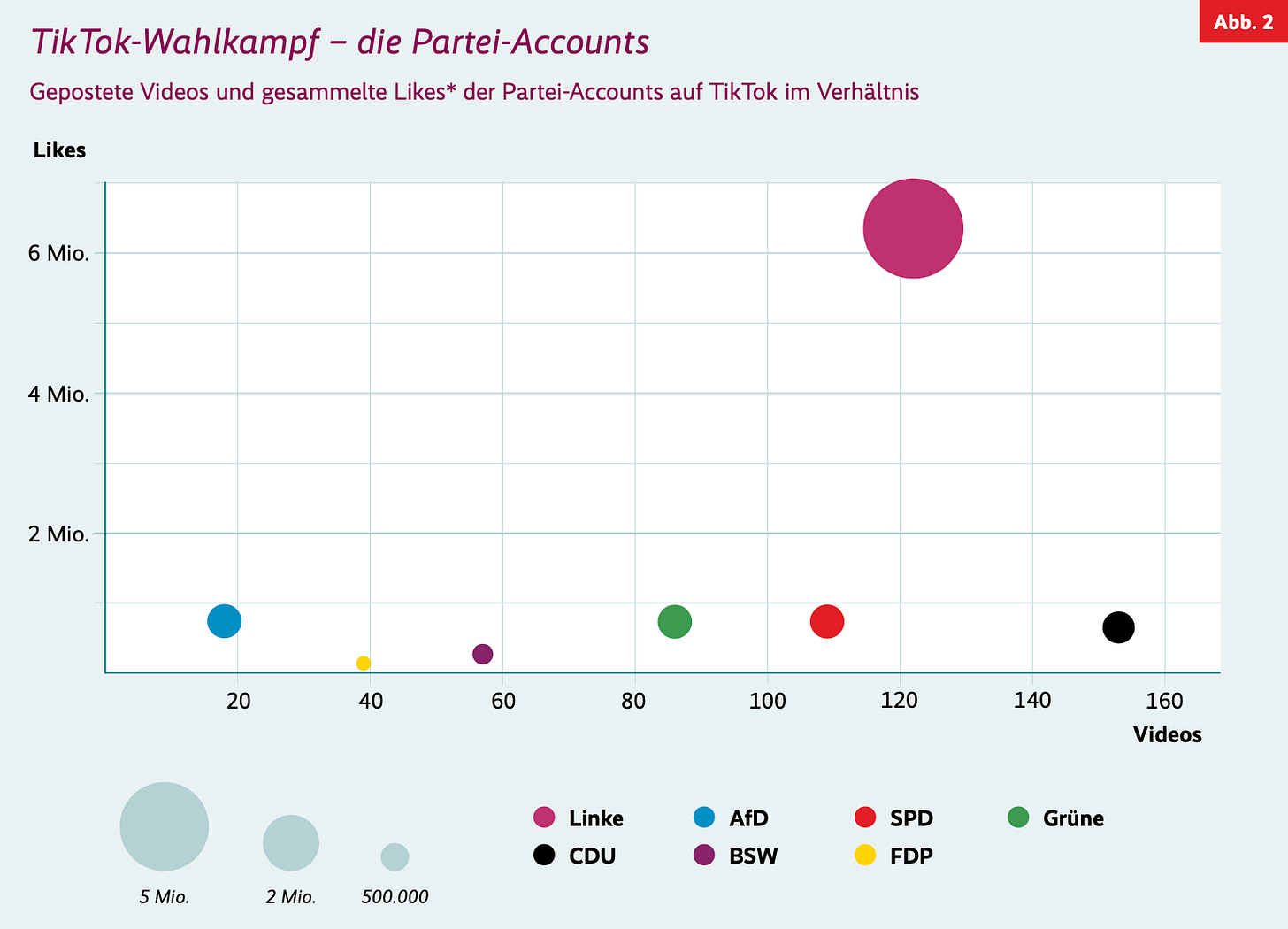Hello.
You are reading Understanding TikTok. My name is Marcus. Have we yet connected on Linkedin?
176 years a day. That is not how old i feel after a day with my kids but the amount of videos uploaded to TikTok. A team of scientists from Canada, the US and Germany has succeeded in reverse-engineering unique identifiers to obtain a complete slice of TikTok (Fast Company | Paper). Using this dataset they estimate that 269 million posts are produced each day. Honestly, i am really stressed trying to watch them all.
🍔 The German TikTok Election
📟 Synthetic Propaganda
🕳️ Signs and symbols
🍔 The German TikTok Election
Together with Jolan Geusen (Linkedin) i have written an analysis of the 2025 federal election campaign on TikTok for Friedrich-Ebert-Stiftung. It just got published here (Website / PDF). We are proud to provide insights on how official and unofficial political accounts were used during the campaign, what strategies proved to be useful or not and we included a set of learnings and policy recommendations.
The 2025 election underscored TikTok’s central role in political campaigning. All major parties engaged actively on the platform, shifting from traditional, rational communication to emotionally resonant, platform-native content.
Especially AfD and Die Linke thrived via unofficial support networks, exploiting participatory affordances. Yet the platform's volatile, trend-driven dynamics demand constant adaptation. To use TikTok effectively for political communication, actors must understand and engage with its unique platform logic. It requires content tailored to its aesthetics, emotional resonance, and trend-driven dynamics. Here are our recommendations:
1. Platform-Specific Content Creation
TikTok is not just a smaller YouTube or an ad channel; it’s a fast-paced, visual, emotional ecosystem. Success relies on producing content that aligns with TikTok’s aesthetics—memes, sounds, vibes. Example: Robert Habeck’s viral “bus driver wave” (Focus) worked because it was tailored to TikTok’s style.
2. Authenticity and Relatability
Politicians gain traction by showing personality and everyday life—not just sharing policy points. Emotional proximity through informal formats (e.g. in a car, at home) builds credibility. Humor, irony, and self-irony resonate strongly on the platform.
Example: Heidi Reichinnek uses direct, unfiltered content to build parasocial relationships and reach (Guardian)
3. Participatory Community Engagement
TikTok thrives on co-creation; one-way communication is ineffective. Parties should enable remixing and adaptation of their content (e.g. via sounds, challenges, downloads). Warning: While the AfD uses intransparent supporter networks, democratic actors should prioritize fairness and transparency – no covert campaigns or bots.
4. Trend Competence and Agility
TikTok requires fast, responsive content production – missed trends mean missed opportunities. Social media teams must be agile, experimental, and platform-literate. "Trial and error" is part of the process; low-effort clips can go viral if they match the TikTok vibe. Example: Friedrich Merz with sunglasses and a Snoop Dogg track –lightweight but trend-aligned (It's the motherfuckin' D-O-double-G).
5. Strategic Influencer Collaboration
Influencers offer built-in trust, reach, and access to niche communities. Effective cooperation requires authenticity and equality—not traditional advertising. Formats like co-creations or challenges work better than scripted promos. Example: Olaf Scholz’s collaboration with Brooklyn (Das Original) showed planned content can succeed if it fits narrative expectations.
Conclusion: TikTok success is not about simply posting — it's about playing the platform. Politicians must be authentic, trend-aware, collaborative, and data-informed to cut through the noise and engage fragmented, digital-native audiences. This may sound obvious, yet rich data lies beyond reach metrics, in understanding how content connects emotionally and socially and can be tailored to user needs.
Link to the entire report here (german). And i am available for briefings, workshops, or strategic exchanges – just drop me a line if you’re interested.
📟 Synthetic Propaganda
There is an endless array of AI-images and videos depicting politicians all around the globe. But there is a special place (Morrissey) reserved for someone special. Images and videos of Donald Trump are disseminated on all platforms, by various actors, including the US president himself, his team and the people responsible for the official White House accounts.
This is interesting because it is unprecedented. As the visual language, the tools used, and the intention (trolling) of this content are basically the same. It does not matter any longer if you are a 13 year old kid with a computer or a well staffed press office when your president wants to mimic the pope or a He-Man meets Star Wars villain. I have started to collect empirical evidence of transgressive content, papers and articles (for a paper) here.
Super happy, that the EU Disinfo lab has chosen my first collection as recommended read – “a must-read for anyone concerned about the role of AI, media manipulation, and disinformation in today’s digital world.” Thanks Ana Romero Vicente!
🕳️ Signs and symbols
"German kids often have little to laugh about, with three or four Germans per 25 students in their classes. German youth are intimidated and often outnumbered; they adapt because they usually have no choice." These lines, sung by a young female voice in German, accompanied by gentle, melancholic music, waft through TikTok (taz).
The sound is used both by people from migrant and left-wing communities and by racists and far-right users. While the latter take the text literally, the former resort to a form of comic relief in a not-so-funny reality of exclusion and everyday racism.
What can be observed here is a new ambivalence in the usage of signs and symbols in certain trends, sounds, brands that carry a variety of meaning depending on the context. Examples include: the brand North Face, being worn by young far-right and far-left activists. The song L’amour toujours by Gigi D’Agostino used in the context of German neo-nazis, paneuropean propaganda and various other political messaging.
I had to think of Pepe the frog (Know Your Meme) and this good article on Hyperallergic: On Twitter, Frogs Were Mostly Nazis, On TikTok, They’re Often Queer. How frogs, more recently seen as a symbol of hate on Twitter, are being queered by TikTok users.
This ambivalence defies fixed attributions and strenghtens uncertainty in an unlimited information environment. Everything is everything (Phoenix). While we are in the midst of a culture clash. Fought (The Clash) on platforms.
📠 What else
TikTok breached digital advertising rules, European Commission says (Politico)
TikTok hit with €530M fine after illegally sending users’ data to China (Politico)
Trump says he’s willing to extend pause on TikTok ban again (The Hill)
The Runaway Tradwives of TikTok (Elle)
TikTok launches TikTok AI Alive (Techcrunch)
Russia’s Use of genAI in Disinformation and Cyber Influence (CRC)
Gendered Harassment During the 2024 EU Parliament Elections on TikTok (ISD)
I have a couple of free slots in the coming months. Happy to offer customized inputs, workshops, consulting or policy papers. If you want to collaborate or are just curious to connect – tap the little letter now 💌








